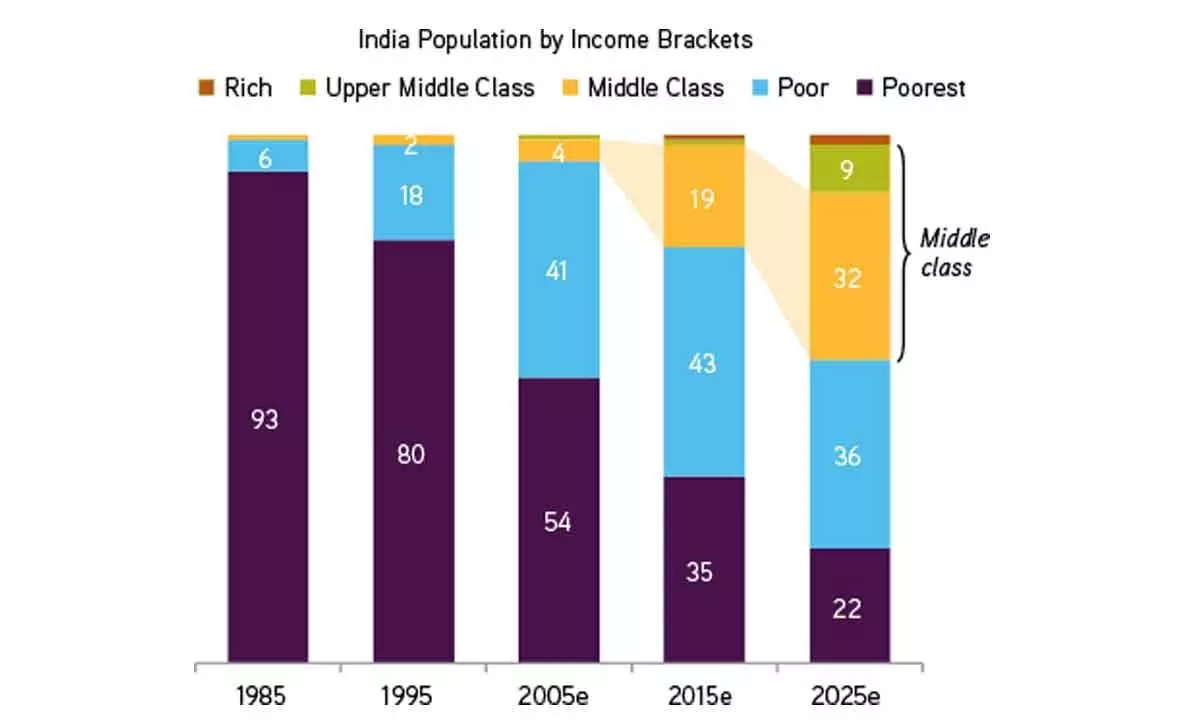Indian middle class has a fast forward growth potential
Around 3.8 crore Indians go abroad seeking to emigrate or acquire permanent residency
image for illustrative purpose

According to McKinsey, India will become the world’s fifth-largest consumer market by 2025 (after the U.S., Japan, China, and the UK). Indians have spent $11.44 billion on overseas travel in the nine-month period of the current fiscal year, from April to December. This does not include shopping, sightseeing, entertainment, hotels, dining and so on once abroad. This figure could easily double when all expenses are taken into account
The Indian middle class, like the rest of the population, is growing exponentially due to constant migration to the cities, which now include more than 20 tier-2 cities. The percentage of the population employed in farming and services in rural areas is declining in line with mechanisation and international trends, while rural prosperity is increasing alongside the growth of GDP.
India’s middle class is set to emerge as its largest group by 2047, also contributing the most to the nation’s income, according to a report made public this Wednesday by the People’s Research on India’s Consumer Economy (PRICE), a not-for-profit think tank.
The report, titled ‘The Rise of India’s Middle Class’, further projects that India, presently the world’s fastest-growing major economy according to the World Bank, will sustain this position with an average annual economic growth rate of 6-7 per cent until 2047.
Approximately, Rs.14.9 lakh is India’s expected per capita income by 2047, compared to Rs. two lakh in 2023 as per a SBI research.
Around 61 per cent the country’s population will have an annual income between Rs. five lakh and Rs.30 lakh by 2047. Around 78% is the expected workforce (515 million) with a taxable base in 2047 compared to 59.1 per cent (313 million) in 2023 as per the SBI Research Data.
It is estimated that the number of Indians travelling abroad for holidays will triple by 2025. This means that about 40 per cent of international travellers will be from India. It’s no wonder that Switzerland recognised that Indian tourists accounted for two or three percentage points of their economy even two decades ago. This is why they have welcome boards out for Indians and many others are following suit.
In its projections for 2030, the report says that the country’s demographics will “change to a rudimentary diamond where a significant part of the low-income class moves to be a part of the middle class.”
Notably, the report highlights that the sheer rich and super-rich income groups experienced growth rates exceeding 10 per cent between 2016 and 2021, while the middle class witnessed growth rates ranging from four to 7.5 per cent. On the other hand, the destitute category saw a contraction of 0.6 per cent during the same period, indicating upward mobility. However, income inequality in India remains substantial, according to the report.
With 570 million Indians below the age of 25, the demand for university education—the golden ticket to well-paying private-sector jobs and entry into the middle class—is the highest it has seen. According to the Ministry of Education, the percentage of 18-24-year-olds enrolling in university has shot up 63 per cent in the past four years.
The rise of India’s middle class also heralds a rise in consumption, especially in urban areas—including emerging middle-tier and smaller cities. According to McKinsey, India will become the world’s fifth-largest consumer market by 2025 (after the U.S., Japan, China, and the UK).
Indians have spent $11.44 billion on overseas travel in the nine-month period of the current fiscal year, from April to December. This does not include shopping, sightseeing, entertainment, hotels, dining and so on once abroad. This figure could easily double when all expenses are taken into account.
Overall, 10.3 crore Indians travelled abroad between 2017 and 2022, with 3.8 crore among them seeking to emigrate or acquire permanent residency in foreign countries like the US, Canada and Australia. Who are these people? Most of the 18 million Indian diaspora, the largest in the world, are temporary migrants to West Asia who remit home most of the $100 billion per annum now. Others are students, a majority of whom do return to India.
In addition, since 2011, more than 1.6 million have become citizens of foreign countries, including 1,83,741 in 2022 alone. In 2021, 1,63,370 Indians renounced their citizenship. Of these, 78,284 became US citizens, followed by Australia with 23,533, Canada with 21,597 and Britain with 14,637. Of course, given our population of 1.4 billion plus, the emigration numbers are very small for us, even as they are significant to the host countries. Many are following their relatives who are already settled abroad. Others are minorities, such as Christians, who feel comfortable moving to Christian countries in the First World. Or Jews, the younger of whom go to Israel. The Anglo-Indians have gone. So have the Armenians and so have some of the young Kolkata Chinese.
As India prospers further and acquires international influence, the number of people wanting to renounce their citizenship may decline, even among such pockets.

